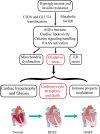Potential Significance of Targeting Ferroptosis for Intervention of Diabetic Cardiomyopathy
- PMID: 40536196
- PMCID: PMC12177803
- DOI: 10.1111/1753-0407.70116
Potential Significance of Targeting Ferroptosis for Intervention of Diabetic Cardiomyopathy
Abstract
Background: Diabetes represents a significant global health concern, with diabetic cardiomyopathy (DCM) emerging as a primary cause of mortality among individuals with diabetes. Despite the prevalence of DCM, advancements in therapeutic and preventative strategies remain constrained.
Methods: Recent studies were reviewed to provide a comprehensive summary of pathogenesis and clinical treatment of DCM, effect of ferroptosis, and potential value of ferroptosis inhibitors in DCM intervention.
Results: A growing body of research indicates that oxidative stress, inflammatory reactions, and other factors play a role in the onset and progression of DCM. Oxidative stress within cardiomyocytes is a primary mechanism implicated in the development of DCM, whereby heightened intracellular reactive oxygen species (ROS) facilitate cell death via ferroptosis. Ferroptosis inhibitors hold great promise as therapeutic agents.
Conclusions: This review provides an overview of the involvement of iron homeostasis regulation, oxidative stress, and ferroptosis in DCM, and the significance of ferroptosis in the prevention and treatment of DCM.
Keywords: diabetes; diabetic cardiomyopathy; ferroptosis; lipid peroxidation; reactive oxygen species.
© 2025 The Author(s). Journal of Diabetes published by Ruijin Hospital, Shanghai JiaoTong University School of Medicine and John Wiley & Sons Australia, Ltd.
Conflict of interest statement
The authors declare no conflicts of interest.
Figures
References
-
- Guariguata L., Whiting D. R., Hambleton I., Beagley J., Linnenkamp U., and Shaw J. E., “Global Estimates of Diabetes Prevalence for 2013 and Projections for 2035,” Diabetes Research and Clinical Practice 103, no. 2 (2014): 137–149. - PubMed
-
- Rubler S., Dlugash J., Yuceoglu Y. Z., Kumral T., Branwood A. W., and Grishman A., “New Type of Cardiomyopathy Associated With Diabetic Glomerulosclerosis,” American Journal of Cardiology 30, no. 6 (1972): 595–602. - PubMed
-
- Bouthoorn S., Valstar G. B., Gohar A., et al., “The Prevalence of Left Ventricular Diastolic Dysfunction and Heart Failure With Preserved Ejection Fraction in Men and Women With Type 2 Diabetes: A Systematic Review and Meta‐Analysis,” Diabetes & Vascular Disease Research 15, no. 6 (2018): 477–493. - PMC - PubMed
Publication types
MeSH terms
Substances
Grants and funding
- 81601664/National Natural Science Foundation of China
- 82470290/National Natural Science Foundation of China
- 2023YFS0036/Sichuan Provincial Science and Technology Program
- WKZX2023CX170004/Clinical Research Program of the National Health Commission of China
- SCU2023G4175/the Fundamental Research Funds for the Central Universities
LinkOut - more resources
Full Text Sources
Medical



